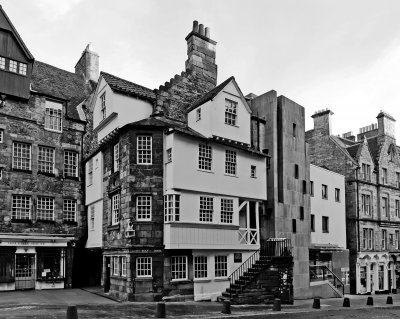Exploring edinburgh
A new chapter for the Scottish Storytelling Centre?
January 11th, 2021When I saw in the Edinburgh Evening News last September the headline, “Hunt for architects to transform John Knox House and Edinburgh's Literary Quarter”, my reaction was “why?”
The report outlined the Edinburgh UNESCO City of Literature Trust’s “long-term cultural development plan for John Knox House and the Scottish Storytelling Centre . . . to create a Literature House for Scotland.” The Trust’s website anticipates the proposed transformation: “Imagine . . . a Literature House for Scotland, the centerpiece of a literary quarter . . . a place dedicated to telling our story as a nation built on books.”
The John Knox House dates from 1470. In the 16th century, it was the home of Mariota Arres whose husband, James Mossman, was goldsmith to Mary Queen of Scots. Their initials are visible outside, along with a figure (Moses, not Knox), a sundial and a carved inscription ‘Luve God abuveal and yi nychtbour as yi self’. Mossman’s story ended with his execution in 1573; punished for his loyalty to the Queen.
The association of the house with the eponymous preacher of the Reformation, who is said to have lived in it, saved it from demolition in the 19th century, thanks for a campaign by Henry Lord Cockburn. A museum since 1853, It was restored in 1910 by the Cockburn Association, which has an office in the cellars. The house is accessed from inside the Scottish Storytelling Centre, the world’s first purpose built national centre for storytelling, opened in 2006. The centre is a good fit between the city’s Writer’s Museum and the Scottish Poetry Library on the Royal Mile. It is popular.
It celebrates diversity. It is egalitarian. Its purpose is expressed in an old Scottish proverb: “The story is told eye to eye, mind to mind and heart to heart”. The building is an award winning retrofit by Malcolm Fraser Architects with Elliott & Company engineers of the former Netherbow Arts Centre, creatively reconfigured internally. Externally, the intervention is an imaginative reinterpretation of historic features on the Royal Mile. The centre’s tower recalls Netherbow Port, the most impressive of the Old Town’s six gates. A plaque with the legend “1606, God save the King”, mounted on the wall of the tower is a relic of It.
The gate was demolished in 1764 because it was too narrow for the increase in “wheeled carriages” and pedestrian traffic. Its bell, cast in the Netherlands in 1621, hangs in a niche at the top of the tower. The bell should be rung as a warning.
The Evening News reported that Edinburgh UNESCO City of Literature Trust was “looking for a really excellent and inspiring design team to work with, and people who understand how special the location is and how important these buildings are to Edinburgh.” The Trust has the support of the Church of Scotland (which owns both buildings), the City of Edinburgh Council, Traditional Arts and Culture Scotland, and (it claims) the local community.
Late last year, a redesign team was appointed. It will be led by Witherford Watson Mann architects (winners of the Stirling Prize 2013) in partnership with conservation specialists Groves-Raines Architects Studios and design agency Studio MB. The appointment followed a competitive public procurement process led by Royal Incorporation of Architects in Scotland, RIAS Consultancy. Malcolm Fraser, who understood “how special the location is and how important these buildings are” when he led the team that designed the Storytelling Centre, tendered but was not selected. He says he was told he had “no relevant experience”.
“Storytelling” is the key word. The reputations of writers associated with Edinburgh led to the city being declared in 2004 the world’s first UNESCO City of Literature. The Writers’ Museum is
dedicated to Burns, Scott and Stevenson. They were storytellers, inspired by Scotland’s oral and theatrical traditions of telling tales - Borders ballads, Gaelic myths and songs, travellers’ tales - a heritage more significant in Scotland than books. “Literary” is not how they and other Scottish writers past and present should be categorized. UNESCO’s designation notwithstanding, “literature” implies cultural superiority to demotic traditions of storytelling.
The issue is not only of semantics but also about architecture. The Trust’s webpage citing the heavyweight team appointed is ominous: “We would like to create a dynamic space where classic design and cutting edge technology tell Scotland’s story of great books and great writers. A place where you can experience an evolving, immersive exhibition - its data-driven wizardry set amongst the painted beams and flagstones of John Knox House, one of Scotland’s most important medieval buildings.”
There is limited scope for intervention in the heritage-listed John Knox House. It seems inevitable that the “immersive exhibition” will dislodge the Storytelling Centre in its current form, clutter its spatial clarity and delete the architectural story it tells.



